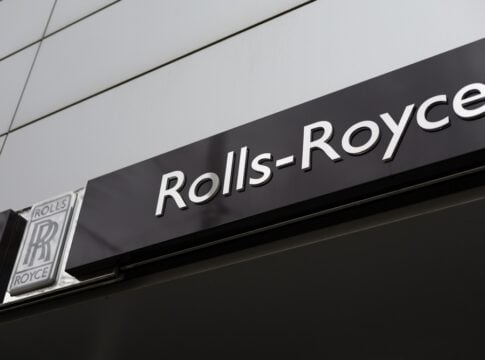Carbon Footprint
Amazon (AMZN) Stock Dips Despite Q2 2025 Beat: Cloud Growth Slows, Net-Zero Push Expands
Amazon reported strong second-quarter results for 2025, exceeding Wall Street expectations on both revenue and earnings. However, a lighter-than-expected guidance for the upcoming quarter and lukewarm growth in its cloud business triggered a sharp stock decline.
Investors, while impressed with the current numbers, are showing concern over the company’s forward momentum, especially in light of increasing competition in the AI-driven cloud space. On the other hand, if we take a peek into its sustainability goals, the retail giants’ emissions are still challenging.
Let’s study the revenue growth and the net-zero plans in the content below:
Despite this strong showing. The market now values the company at approximately $2.44 trillion.
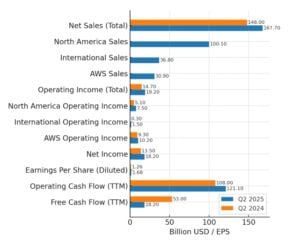
AWS Struggles to Keep Pace in AI Race
Amazon Web Services (AWS), long the crown jewel of Amazon’s business, grew 17% to $30 billion in revenue. While that’s still solid, it fell just short of expectations ($30.78 billion) and didn’t match the high momentum shown by Microsoft’s Azure and Google Cloud Platform.
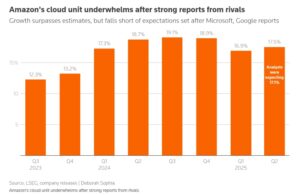
AMZN Stock Slides but Analysts Still See Upside
Reuters reported that investors are holding Amazon to a higher standard, especially as Microsoft and Google have both shown clear AI-driven revenue jumps in their cloud platforms. While Amazon is also investing heavily in AI, the returns haven’t yet wowed investors.
So far in 2025, Amazon’s stock had gained around 7% leading up to the earnings announcement. But after the company issued weaker-than-expected guidance, some investors pulled back, causing the stock to dip in after-hours trading.
Even so, market sentiment remains mostly positive. Analysts are still confident in the company’s long-term growth and expect the AMZN stock to recover soon. Many have set short-term price targets between $234 and $238 by the end of August 2025.
Meanwhile, full-year 2025 consensus estimates project earnings per share (EPS) of around $6.29. This signals faith in the company’s fundamentals despite short-term uncertainty.

Future Guidance Adds to Market Jitters
Amazon’s Q3 2025 guidance suggests net sales between $174 billion and $179.5 billion, a projected 10% to 13% increase over Q3 2024. The company also forecasts operating income of $15.5 billion to $20.5 billion, compared with $17.4 billion a year earlier.
Though these are healthy figures, they indicate slowing growth and rising spending. Capital expenditure for 2025 is now expected to exceed $118 billion—well above rivals—fueling concerns over shrinking margins.
Amazon’s Emissions Still a Big Challenge
Amazon says it’s working to cut its carbon footprint. The company has reduced its Scope 1 and 2 emissions slightly by utilizing more renewable energy and improving the efficiency of its buildings. These emissions come from its operations and the electricity it buys.
But Scope 3 emissions—which come from suppliers, product shipping, and customer use—are still going up. These emissions make up over 75% of the company’s total carbon output. As the company builds additional data centers and expands its cloud and AI services, these indirect emissions may increase further.
Amazon has promised to reach net-zero carbon by 2040. Still, some experts say the company needs to share more details about these indirect emissions and do more to cut them across its supply chain.

Electrifying Delivery Fleet
Amazon has aggressively ramped up its electric delivery vehicles (EVs).
- As of mid-2025, the company has delivered 1.5 billion packages using over 31,400 EVs.
- It also built the largest private charging network in the U.S. with 11,770 chargers across 50 delivery stations.
- In Europe, it is adding over 200 Mercedes-Benz eActros 600 electric trucks, expected to carry around 338 million packages annually.
Renewable Energy Milestone Reached Early
Amazon pledged to power all its operations with 100% renewable energy by 2025, but achieved this target two years early in 2023. Today, it matches 100% of its global electricity usage with renewables, primarily through wind and solar projects.
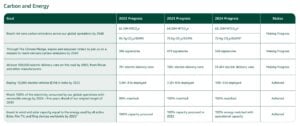
READ MORE:
- Amazon Leads Corporate Clean Energy Contracts, Hitting Record High at 100GW
- Amazon to Power AI Data Center Expansion with 1,920 MW Nuclear PPA from Talen Energy
- Amazon Expands Renewable Energy with 17 New Projects in Spain & First in Portugal
Cleaner Fuels and Smarter Shipping
In 2024, the company scaled up its use of cleaner fuels. It used 4.7 million gallons of renewable diesel, compared to just 286,300 gallons the year before. It also bought 3.7 million gallons of blended sustainable aviation fuel to cut emissions from air transport.
It also improved delivery routes. By offering customers smarter shipping options, it saved over 452 million delivery trips and reduced the use of more than 494 million boxes. These changes helped avoid an estimated 335,000 metric tons of carbon emissions in 2024 alone.
Making Packaging and Logistics Greener
Amazon is cutting emissions by bringing fulfillment centers closer to customers, reducing delivery distances and fuel use. It uses more rail transport instead of trucks to lower emissions.
In cities, it relies on on-foot deliveries and electric cargo bikes for short trips as well. This cuts pollution and eases traffic. The company also invests in lighter, recyclable packaging, aiming to have half of its shipments be net-zero carbon by 2030.
Expanding Carbon Removal Projects
While Amazon is cutting emissions through renewable energy and electrification, it’s also backing large-scale carbon removal efforts. These initiatives are vital for tackling the emissions that cannot be completely avoided.
It is investing heavily in nature-based solutions like reforestation, wetland restoration, and soil carbon capture. The company partners with trusted environmental organizations and developers to ensure these projects meet strict environmental and scientific standards.
Additionally, Amazon also funds early-stage technologies focused on direct air capture (DAC) and ocean-based carbon removal. These advanced methods pull CO₂ directly from the air or water and lock it away permanently. The company views these long-term technologies as crucial to scaling carbon removal in the decades ahead.
By building out a global portfolio of carbon removal projects, Amazon is not only addressing its own footprint but also helping grow the carbon market and drive down the cost of climate solutions.
Amazon’s Game-Changing Carbon Credit Platform
Amazon launched a carbon credit platform through its Sustainability Exchange to help suppliers and partners reach their net-zero goals. This new service gives qualified companies access to high-quality carbon credits. These credits come from real projects that either remove CO₂ from the air or prevent its release.
Unlike many carbon marketplaces, Amazon’s platform is selective. It only allows companies that set net-zero targets, measure and report emissions, and commit to cutting carbon in line with climate science.
Driving Real Change Beyond Offsetting
This platform goes beyond simple offsetting. It aims to enable real decarbonization across Amazon’s entire value chain. By offering vetted credits to customers, suppliers, and Climate Pledge members, Amazon unlocks new private funding for effective climate projects.
Over time, this platform could make Amazon a leader in corporate carbon management—not just logistics or cloud services. Plus, it encourages collaboration by providing educational tools, playbooks, and a space for companies to share best practices. This broad approach could speed up the decarbonization of many industries.
As Amazon navigates the twin challenges of AI-driven cloud competition and rising operating costs, its environmental leadership and aggressive long-term planning offer strong fundamentals for future growth.
- READ MORE: Amazon Unveils Carbon Credit Investment Service: A Game Changer for Corporate Sustainability
The post Amazon (AMZN) Stock Dips Despite Q2 2025 Beat: Cloud Growth Slows, Net-Zero Push Expands appeared first on Carbon Credits.
Carbon Footprint
Rolls-Royce Stock Soars with 50% Profit Surge, Strong SMR Partnerships, and Net Zero Drive
Rolls-Royce reported a 50% jump in underlying operating profit to £1.7 billion in the first half of 2025. The operating margin rose to 19.1%, up from 14% last year. This increase shows the effect of strategic changes, smarter operations, and cost discipline.
- Revenue grew by 10.8% to £9.06 billion and free cash flow hit £1.58 billion, driven by higher profits and solid performance from long-term service agreements (LTSA).
- Its market value topped £90 billion for the first time, placing it among the top five firms in the FTSE 100.
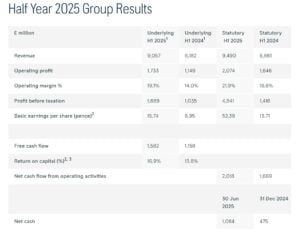
CEO Tufan Erginbilgic, said:
“Our multi-year transformation continues to deliver. Our actions led to strong first half year results, despite the challenges of the supply chain and tariffs. We are continuing to expand the earnings and cash potential of Rolls-Royce.
We delivered continued strong operational and strategic progress in the first half of 2025. In Civil Aerospace, we achieved significant time on wing milestones and delivered improved aftermarket profitability. In Power Systems, where we now see further growth potential, we continued to capture profitable growth across data centres and governmental. In addition, Rolls-Royce SMR was selected as the sole provider of the UK’s first small modular reactor programme. We expect Rolls-Royce SMR to be profitable and free cash flow positive by 2030.”
Rolls-Royce Holdings PLC (RYCEY) Stock Performance
Rolls-Royce Holdings PLC has seen a strong comeback in 2025, following record profits. On July 31, Rolls-Royce reported a significant beat on its first-half operating profit and free cash flow, raising full-year forecasts. The company posted a 50% jump in operating profit to £1.7 billion and increased its guidance for 2025 operating profit to between £3.1 billion and £3.2 billion (up from a prior range of £2.7–£2.9 billion), and free cash flow to £3.0–£3.1 billion.
This strong performance was driven by:
- Substantial improvements in its civil aerospace business, with higher utilization and engine flying hours surpassing pre-pandemic levels.
- Growing power systems sales to data centers and government contracts.
- Robust order intake, particularly for large aircraft engines.
- Successful delivery on turnaround strategies set by the CEO, including enhanced profitability and margin expansion across divisions.
The jump reflected renewed investor confidence and belief that the company can sustain this growth trajectory. The day’s gain of about 10% made Rolls-Royce one of the top performers in major European indices and resulted in record share prices.
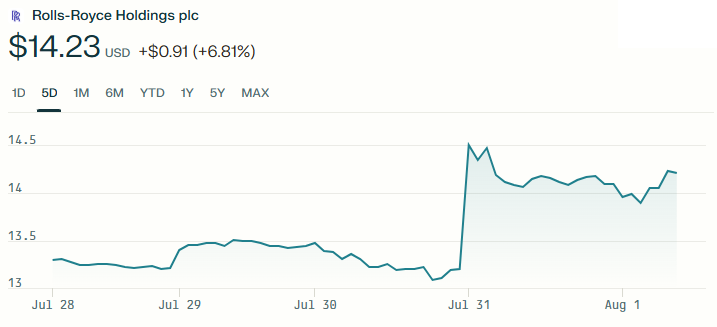
Analysts have praised the results. Shore Capital called them “excellent,” noting strong margins in Civil Aerospace. Morgan Stanley mentioned that the company’s guidance might be conservative, given the current momentum.
The firm also pleased investors by announcing an interim dividend of 4.5p per share, payable in September. Additionally, it completed £400 million of its planned £1 billion share buyback, boosting shareholder confidence.
The company raised its full-year forecast, now expecting £3.1 billion to £3.2 billion in profit and £3.0 billion to £3.1 billion in free cash flow.

SMRs Set to Power Rolls-Royce’s Nuclear Ambitions
The company’s clean energy vision centers on its Small Modular Reactor (SMR) program. It is making great progress and aims to be a global leader in SMRs.
Key SMR Developments:
-
UK Government Deal: Rolls-Royce was selected by Great British Energy – Nuclear as the preferred bidder to develop Britain’s first SMRs, supported by £2.5 billion in public funding.
-
Czech Republic Partnership: A partnership with ČEZ Group aims to deploy up to 3GW of clean energy in the Czech Republic, with more opportunities in Central Europe.
-
Growing Nuclear Ties: The UK and Hungary are deepening cooperation, potentially opening more SMR opportunities.
-
Technology Backing: Siemens Energy will supply steam turbines and generators, while Westinghouse is developing nuclear fuel for Rolls-Royce SMRs.
These collaborations enhance technical capabilities, lower costs, and support global SMR deployment.
Research and Supply Chain Push
Rolls-Royce is teaming up with the University of Sheffield’s AMRC. They aim to enhance modular manufacturing methods. This partnership will speed up production and lower costs for SMR.
As a member of the European Industrial Alliance on SMRs, Rolls-Royce collaborates with governments and industry to boost energy security and expand nuclear energy across Europe.
The company plans to form new utility partnerships in Asia and North America. It also aims to expand its supply chain with local engineering partners. There’s potential to link SMRs with energy storage and hydrogen. This could position them as a clean energy backbone for the future.
Rolls-Royce Aims Net Zero by 2050: Real Progress, Not Offsets
Rolls-Royce has made climate leadership a priority. It aims for net zero by 2050, not just in its operations but also across its products.
The company avoids relying on carbon offsets. Instead, it focuses on cutting emissions through innovation, efficient operations, and renewable fuels.
Here’s how it is cutting Scope 1 and 2 emissions from its operations:
It targets a 46% emissions cut by 2030, based on 2019 levels. The goal is to reach net zero emissions from its operations by 2050. This includes emissions from engine testing, which have increased due to higher development activity.
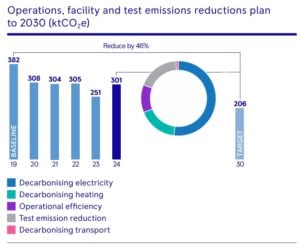
The company plans to use sustainable aviation fuel (SAF) in tests. They are shifting to clean power sources and installing batteries in locations like Friedrichshafen. Additionally, they are also buying renewable energy and focusing on efficiency improvements.
- In 2024, total Scope 1 and 2 emissions increased to 301 ktCO2e. This rise includes a 55 ktCO2e jump in test-related emissions.
- However, operational emissions dropped by 5 ktCO2e, a 3% decrease, which indicates progress.

Scope 3 Focus: Tackling Value Chain Emissions
Beyond direct emissions, Rolls-Royce is addressing Scope 3 emissions—especially from the use of its products (category 11) and purchased goods and services (category 1). These are major sources, with purchased goods accounting for 2.18 MtCO2e in 2024, around 2.5% of total emissions.
It is working with suppliers to set net zero targets, partnering with logistics firms for low-emission transport, and promoting resource efficiency to reduce waste.

Innovation for Cleaner Products
Rolls-Royce is investing significantly in future-ready, low-carbon products. They aim to ramp up their R&D spending on net-zero technologies by 75% this year.
Notable milestones include the UltraFan engine, a next-gen demonstrator with high fuel efficiency and SAF compatibility. All current in-production aero engines are certified to run on 100% sustainable aviation fuel. The company’s SMR projects aim to deliver scalable, clean electricity to national grids.
These projects are vital for its net-zero strategy and essential for decarbonizing the heavy industry and global aviation sectors.
All in all, Rolls-Royce demonstrates that climate action and financial growth can be mutually beneficial. From record profits to world-class clean tech investments, Rolls-Royce exemplifies how legacy companies can become climate leaders even without carbon credits. This approach helps create a responsible and profitable future.
- FURTHER READING: UK Bets on Rolls-Royce for Its First Small Modular Nuclear Reactors With £2.5B Pledge
The post Rolls-Royce Stock Soars with 50% Profit Surge, Strong SMR Partnerships, and Net Zero Drive appeared first on Carbon Credits.
Carbon Footprint
Microsoft (MSFT) to Get Fusion Power as Helion Energy Kicks Off Orion Plant Construction
In a major leap toward commercial fusion energy, Washington-based Helion has begun site work on its first fusion power plant, Orion. The move marks a defining moment for both Helion and its key partner, Microsoft.
In 2023, Helion signed the world’s first power purchase agreement (PPA) for fusion energy, committing to supply electricity to Microsoft once the plant is operational. Located in Chelan County, Washington, the site was selected for its easy access to power transmission and its legacy of energy innovation.
This project represents a significant step in Helion’s mission to bring fusion electricity to the grid by 2028. Constellation Energy will serve as the power marketer. Now, with construction efforts underway, Helion is staying on track to meet the 2028 target.
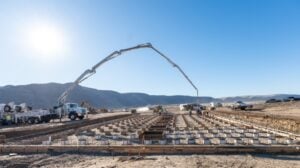
Helion’s Fusion Breakthrough: A Clean Energy Milestone
Fusion energy—the process that powers the sun—has long been viewed as the ultimate solution to the world’s energy needs. It offers virtually unlimited, clean energy without carbon emissions or long-lived radioactive waste. If Helion succeeds in delivering fusion electricity to the grid, it could mark a paradigm shift in how the world powers itself.
Over the past decade, Helion has built six fusion prototypes and made steady technical progress through rapid iteration and testing. Its sixth machine, Trenta, made history by achieving a fuel temperature of 100 million degrees Celsius—considered the minimum threshold for fusion to become commercially viable.
Now, Helion is constructing its seventh and most advanced prototype, Polaris. This machine is expected to go further than any before it: demonstrating not just fusion reactions, but also the first electricity produced directly from fusion.
Polaris: A Critical Step Toward Commercial Fusion
Polaris represents a major step in Helion’s roadmap to build a zero-carbon fusion generator. It will improve upon previous machines in several key ways:
- Higher Frequency Pulses: Polaris is designed to pulse faster than Trenta, allowing more frequent fusion reactions.
- Stronger Magnetic Fields: Enhanced magnets will provide improved plasma confinement, essential for sustaining the extreme conditions needed for fusion.
- Direct Electricity Generation: Unlike traditional fusion designs that rely on steam turbines, Polaris is built to demonstrate direct electricity generation from fusion reactions, a critical innovation for scalable deployment.
If successful, Polaris will become the first fusion machine—public or private—to show that fusion can generate electricity in a compact system. Its success will provide the foundation for Orion, the first commercial-scale plant aiming to deliver fusion electricity to Microsoft and the wider grid.

From Permits to Power: Orion Prepares to Energize the Grid
Helion began building the Orion facility on leased land from the Chelan County Public Utility District. The project cleared Washington’s rigorous environmental review process, receiving a Mitigated Determination of Non-Significance (MDNS) under SEPA guidelines.
Since 2023, Helion has actively collaborated with government agencies, Tribal Nations, and local stakeholders to prepare for the construction and operation phases. The company’s transparent approach to permitting and community engagement has helped smooth the path for the project.
After a one-year ramp-up period, the fusion power plant is expected to generate at least 50 megawatts (MW) of electricity. If successful, the Orion project could fast-track fusion’s role in global clean energy supply—years ahead of other industry projections.
- READ MORE: Google Backs Fusion Energy: Signs 200MW Offtake Agreement with Commonwealth Fusion Systems
Microsoft’s Energy Shift: From Solar to Fusion and Fission
Helion’s fusion energy isn’t the only clean power solution Microsoft is betting on. As the tech giant races to meet its ambitious climate goals to become carbon negative by 2030, it has also turned to traditional nuclear energy. The growing power demands of artificial intelligence (AI) and cloud computing have made constant, reliable energy a top priority.
While wind and solar remain crucial parts of Microsoft’s strategy but their intermittency creates challenges for powering massive data centers around the clock.
That’s where nuclear energy enters the equation. Microsoft has invested in multiple nuclear projects, including a 20-year PPA to purchase power from the restarted Three Mile Island nuclear facility in Pennsylvania. This deal alone will supply over 800MW of carbon-free electricity to Microsoft’s operations starting in 2028.

AI and the Rising Demand for Energy
Microsoft’s clean energy push is largely driven by surging electricity needs tied to AI development and cloud infrastructure. Industry analysts expect data center energy use to double by 2028, fueled by generative AI technologies and hyperscale computing. Between 2020 and now, Microsoft’s total energy use rose by 168%, driven by a 71% increase in revenue and significant expansion in its cloud operations.
At the same time, Microsoft’s emissions have gone up by 23.4% compared to its 2020 baseline. While this rise is modest relative to the company’s operational growth, it underscores the difficulty of decarbonizing at scale. Fusion and nuclear energy offer Microsoft a path forward—delivering stable, 24/7 clean electricity that wind and solar alone can’t guarantee.
Supporting Innovation and Clean Energy Leadership
The tech giant is becoming a leader in reshaping the nuclear and fusion energy industry. The company signed its first large-scale nuclear PPA with the Crane Clean Energy Center in 2024. That agreement will enable the restart of an 835MW nuclear plant in Pennsylvania, retired in 2019. The plant’s return will inject new clean energy into the PJM power grid, one of the largest in the U.S. and critical to Microsoft’s East Coast data centers.
By partnering with emerging fusion firms like Helion and supporting small modular reactor (SMR) projects, Microsoft is also fueling innovation in next-generation nuclear technologies. These efforts don’t just benefit Microsoft—they send a strong signal to markets, encouraging other corporations to invest in scalable, zero-carbon power solutions.
In fact, Microsoft’s influence is already visible across the energy sector. Its clean energy strategy is helping revive shuttered nuclear facilities, create local jobs, and guide public policy toward advanced carbon-free solutions.
Economic and Community Benefits
The economic ripple effects of Microsoft’s nuclear partnerships are expected to be substantial. Reviving plants like Three Mile Island will bring billions of dollars in investment and long-term job creation to surrounding communities. These projects also help maintain grid stability as power demand continues to grow.
Moreover, Helion’s Orion project could turn Chelan County into a global showcase for fusion innovation. If Polaris succeeds in producing electricity, Helion would not only lead the private fusion race but also bring global attention to the Pacific Northwest as a clean tech hub.
How Big Tech Is Reshaping the Clean Energy Landscape
Alongside Microsoft, Amazon, Google, and Meta are the hyperscalers driving renewable and nuclear energy adoption. As projected by S&P Global Insights, collectively, these tech giants have amassed more than 84 gigawatts of clean energy capacity across 29 countries. This scale is transforming global corporate energy markets, shifting clean energy from a sustainability perk to a business necessity.
Additionally, Microsoft has also joined influential advocacy groups like the Fusion Industry Association and the U.S. Nuclear Industry Council (USNIC), strengthening its voice in policy and industry discussions around the future of energy.
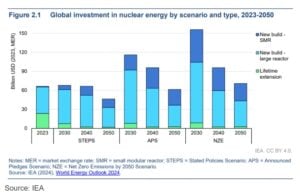
The partnership between Helion and Microsoft is more than a fusion pilot—it’s a turning point for nuclear energy innovation. As the Orion plant moves forward, it could accelerate the arrival of commercial fusion while giving Microsoft a reliable, zero-carbon energy source to support its rapidly growing AI infrastructure.
The post Microsoft (MSFT) to Get Fusion Power as Helion Energy Kicks Off Orion Plant Construction appeared first on Carbon Credits.
-
Climate Change2 years ago
Spanish-language misinformation on renewable energy spreads online, report shows
-
Climate Change Videos2 years ago
The toxic gas flares fuelling Nigeria’s climate change – BBC News
-

 Greenhouse Gases1 year ago
Greenhouse Gases1 year ago嘉宾来稿:满足中国增长的用电需求 光伏加储能“比新建煤电更实惠”
-

 Climate Change1 year ago
Climate Change1 year ago嘉宾来稿:满足中国增长的用电需求 光伏加储能“比新建煤电更实惠”
-

 Carbon Footprint1 year ago
Carbon Footprint1 year agoUS SEC’s Climate Disclosure Rules Spur Renewed Interest in Carbon Credits
-
Climate Change2 years ago
Why airlines are perfect targets for anti-greenwashing legal action
-
Climate Change Videos2 years ago
The toxic gas flares fuelling Nigeria’s climate change – BBC News
-
Climate Change2 years ago
Some firms unaware of England’s new single-use plastic ban


